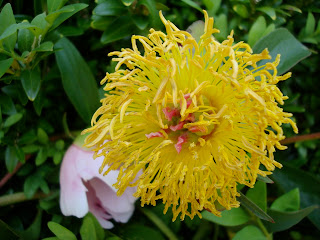The Stranger's Challenge - Part II
A gentleman stranger challenged me to plant my tomatoes differently than I'd done in the past. I did what he suggested without thinking twice. Inspired by the fun of this experiment, I jumped straight into another: eco-dyeing.
Conceding a little to the fact that I don't have complete control over my schedule, I've decided to pursue cold dyeing as opposed to the more traditional dye extraction methods involving pots filled with simmering water that are carefully watched in an attempt to avoid turning everything brown. I'm just not that good. But with the cold temperature approach as described in India Flint's book Eco-Colour, harvested flora are first frozen and then allowed to steep in cold water to release their color. That suits me just fine.
There are a number of lists of plants to use, though they are a bit is skewed to Flint's native Australia (I can only pick up eucalyptus at the store, instead of my backyard). Still, all the possibilities are exciting to me and although neither is listed in any botanical dye list I could find in the book or on the internet, I scoured the yard on Saturday for dropped (and drooping) peony and rhododendron petals. The rains had battered some of my peonies so I plucked the petals, leaving one denuded but still lovely flower
and jammed its petals into a Ziploc bag with all the rest I'd recovered.
The baggie now sits in my freezer, waiting for the day when I have time to see if any color will leech from the petals. Chances are that nothing will come of it, but that's okay. I have my PFD fabric ready to go, ash collected from the fireplace (thank heavens I hadn't cleaned the fireplace yet), and a giant aluminum stockpot I luckily found on sale at the grocery store, labelled for experimentation.
Yesterday some of my rose petals fell so I gathered those up too since they ARE supposed to create a wonderful dye. Not surprisingly -- look at the gorgeous colors! I think I need to gather more before I can dye. I don't know if the dye process will be impacted by petals harvested at different times and therefore, frozen for different lengths of time. I wonder if the very light petals, which look bleached by the sun, can still give off any color. I guess we'll find out.
Conceding a little to the fact that I don't have complete control over my schedule, I've decided to pursue cold dyeing as opposed to the more traditional dye extraction methods involving pots filled with simmering water that are carefully watched in an attempt to avoid turning everything brown. I'm just not that good. But with the cold temperature approach as described in India Flint's book Eco-Colour, harvested flora are first frozen and then allowed to steep in cold water to release their color. That suits me just fine.
There are a number of lists of plants to use, though they are a bit is skewed to Flint's native Australia (I can only pick up eucalyptus at the store, instead of my backyard). Still, all the possibilities are exciting to me and although neither is listed in any botanical dye list I could find in the book or on the internet, I scoured the yard on Saturday for dropped (and drooping) peony and rhododendron petals. The rains had battered some of my peonies so I plucked the petals, leaving one denuded but still lovely flower
and jammed its petals into a Ziploc bag with all the rest I'd recovered.
The baggie now sits in my freezer, waiting for the day when I have time to see if any color will leech from the petals. Chances are that nothing will come of it, but that's okay. I have my PFD fabric ready to go, ash collected from the fireplace (thank heavens I hadn't cleaned the fireplace yet), and a giant aluminum stockpot I luckily found on sale at the grocery store, labelled for experimentation.




Comments